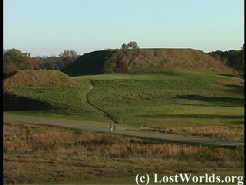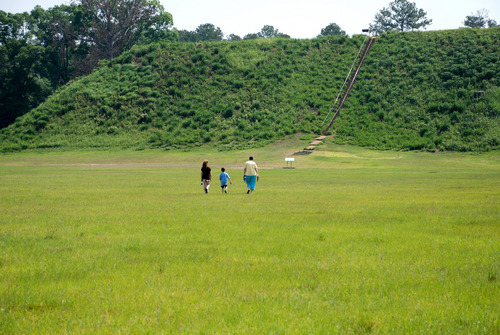Ancient Native American Sites in Georgia | Part 6: Ocmulgee Mounds
 Ocmulgee Mounds National Monument in Macon, GA is the site of one of the largest Native American cities in the U.S. and likewise is home to the tallest earthen pyramid. Consisting of seven mounds and earthen pyramids built around 800 AD, the tallest of these structures is known as the Great Temple Mound. It was constructed on the edge of a plateau and rises some 56 feet from the surface of the plateau. Yet the builders ingeniously terraced the plateau so that it matched the same angle as the pyramid thus incorporating the plateau into the overall design of this enormous structure. By so doing, the total height of this pyramid totals 90 feet tall from the base of the plateau to the top of the mound.
Ocmulgee Mounds National Monument in Macon, GA is the site of one of the largest Native American cities in the U.S. and likewise is home to the tallest earthen pyramid. Consisting of seven mounds and earthen pyramids built around 800 AD, the tallest of these structures is known as the Great Temple Mound. It was constructed on the edge of a plateau and rises some 56 feet from the surface of the plateau. Yet the builders ingeniously terraced the plateau so that it matched the same angle as the pyramid thus incorporating the plateau into the overall design of this enormous structure. By so doing, the total height of this pyramid totals 90 feet tall from the base of the plateau to the top of the mound.
It is thought that several structures were once located at the top of this pyramid including a temple and possible chief’s residence. A terrace or low mound was eventually connected to this great mound which also served as the location for a structure.
Next to Great Temple Mound is a smaller temple mound which is believed to have been the home of a lesser chief. Between these two mounds is an open space believed to be a court yard used for festivals, games and market days.
A burial mound is located not far from these structures. Inside archaeologists unearthed all manner of seashell jewelry and broken pottery buried with the deceased. One likely Chief recovered from this burial mound was wearing a headdress made from the lower jaw of a mountain lion encased in sheets of copper. Additional copper decorations attached to the headdress were embossed with the image of a rising sun.
A spectacular building was unearth near the center of this complex. Known as the Earth Lodge, it was a round, earth-covered building that enclosed a circle of 50 seats built into the floor of the structure. At the front of the circle were three raised seats built into the shape of a bird that were undoubtedly reserved for the leaders of this community.
It appears that two separate groups of people occupied this site at different times. The original builders practiced ritual cranial deformation wherein they shaped their skulls from birth to have a flat forehead and enlongated skull. Later inhabitants did not participate in this practice as evidenced by their skeletal remains. The pottery at this site also reveals that it was invaded and the original occupants displaced. The original pottery was replaced by a completely foreign style. Yet eventually the two styles merged hinting at some form of reconciliation between the two populations.
The site houses an excellent museum with many artifacts but the real stars of the show are the mounds themselves. Located about three hours west of Savannah via I-16, this short trip will take you back over 1200 years into America’s Native American past.
For More Info
- Read my more in-depth Ocmulgee Mounds article @ LostWorlds.org
- Buy my “Lost Worlds: Georgia” DVD



